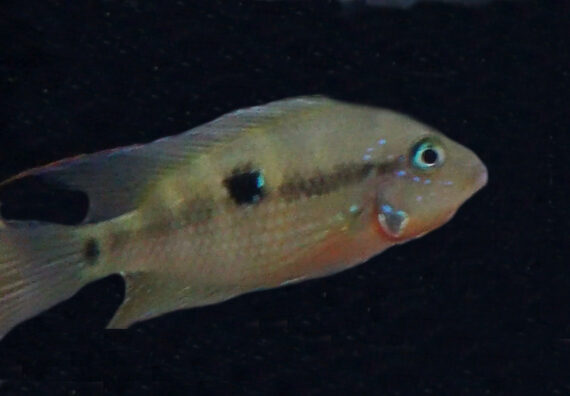Firemouth Cichlid, Thorichthys meeki
 Firemouth Cichlid, Thorichthys meeki. Underwater photograph taken within the Sian Ka’an Biosphere Reserve, Quintana Roo, March 2021. Photograph courtesy of Marina Sutormina, Stockholm, Sweden. Identification courtesy of Dr. John Lyons, Madison, Wisconsin.
Firemouth Cichlid, Thorichthys meeki. Underwater photograph taken within the Sian Ka’an Biosphere Reserve, Quintana Roo, March 2021. Photograph courtesy of Marina Sutormina, Stockholm, Sweden. Identification courtesy of Dr. John Lyons, Madison, Wisconsin.
The Firemouth Cichlid, Thorichthys meeki, is a member of the Cichlid and Tilapia or Cichlidae Family, known in Mexico as Mojarra boca de fuego. They are named for their bright red-orange throats. Globally, there are nine species in the genus Thorichthys, with seven being found in the freshwater systems of Mexico.
The Firemouth Cichlid has a “bluegill” body profile that is extremely laterally compressed with a steeply sloping forehead and a pronounced snout. They are known for the bright red or orange undersides of their heads that extends to the caudal peduncle. Their bodies are blue-gray with several black blotches on the sides; their fins are light brown and streaked with metallic blue. They are sexually dimorphic with males being larger, more brightly colored, specifically around the throat and have more pointed anal and dorsal fins than females. Their caudal fin is truncate to lunate; their pectoral fins are long and pointed and extend past the anal fin origin.
The Firemouth Cichlid is a freshwater robust, gregarious fish that is found in groups in shallow slow-moving cenotes, ditches, lagoons, ponds, rivers and streams that can be clear to turbid with sand or mud substrate that have rocks and algal vegetation, beds of leaf litter and submerged branches with temperatures between 23oC (75oF) and 30oC (86oF). They reach a maximum of 17 cm (6.7 inches) in length. They are known to burrow into the substrate. They are an omnivore sand sifter consuming anelids, crustaceans, and detritus. They rely on their fin spines for protection from predation. Reproduction is oviparous and monogamous in pairs with the females laying between 100 and 500 eggs which are immediately fertilized by the males, in depressions in sandy and muddy substrates. Their territories are vigorously defended by the males, with colorful displays of their gills which have bright red membranes and iridescent eye spots. The females care for the young, and each couple will raise several broods per year. They are non-migratory and have life spans of fifteen years.
The Firemouth Cichlid, due to its red throat and red underside, is a straightforward identification that cannot be easily confused with any other species.
The Firemouth Cichlid is native to the lowland areas on the Atlantic Slope of southeast Mexico from the Río Tonalá in Veracruz southward within the states of Campeche, Chiapas, Quintana Roo, Tabasco, Veracruz and Yucatán.
From a conservation perspective The Firemouth Cichlid is currently considered to be of Least Concern with stable, widely-distributed populations. Their long-term viability is threated by human developments that cause altered water supplies and pollution and the introduction of non-native species by commercial and sports fishermen, as well as highly invasive aquatic vegetations. They are popular with the aquarium trade due to their color, small stature and ease of care, being very hardy but have fairly aggressive behavior when breeding. All fish sold by the aquarium trade have been bred in captivity. The Firemouth Cichlid has been utilized by the scientific community to study animal behavior.